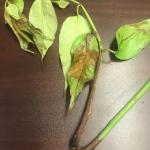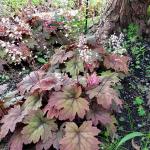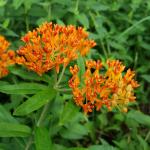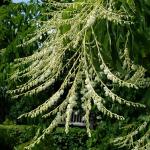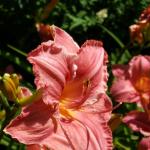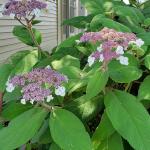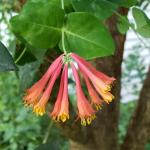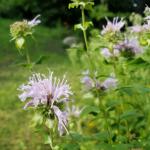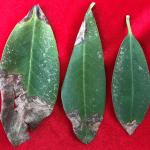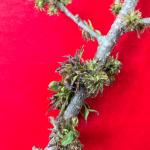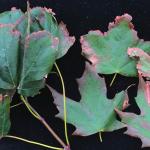UMass Extension's Landscape Message is an educational newsletter intended to inform and guide Massachusetts Green Industry professionals in the management of our collective landscape. Detailed reports from scouts and Extension specialists on growing conditions, pest activity, and cultural practices for the management of woody ornamentals, trees, and turf are regular features. The following issue has been updated to provide timely management information and the latest regional news and environmental data.
To read individual sections of the message, click on the section headings below to expand the content:
Scouting Information by Region
Environmental Data
The following data was collected on or about July 24, 2019. Total accumulated growing degree days (GDD) represent the heating units above a 50° F baseline temperature collected via our instruments for the 2019 calendar year. This information is intended for use as a guide for monitoring the developmental stages of pests in your location and planning management strategies accordingly.
|
MA Region/Location |
GDD |
Soil Temp |
Precipitation |
Time/Date of Readings |
||
|
2-Week Gain |
2019 Total |
Sun |
Shade |
|||
|
CAPE |
357.5 |
1217.5 |
74 |
70 |
3.79 |
12:00 PM 7/24 |
|
SOUTHEAST |
365 |
1338.5 |
88 |
76 |
1.79 |
3:00 PM 7/24 |
|
NORTH SHORE |
349 |
1296.5 |
68 |
63 |
1.38 |
10:00 AM 7/24 |
|
EAST |
382.5 |
1432.5 |
78 |
69 |
3.85 |
5:00 PM 7/24 |
|
METRO |
342 |
1324.5 |
72 |
66 |
4.6 |
4:00 PM 7/24 |
|
CENTRAL |
343.5 |
1372 |
72 |
62 |
4.25 |
4:15 PM 7/24 |
|
PIONEER VALLEY |
378.5 |
1396 |
77 |
68 |
2.6 |
3:00 PM 7/24 |
|
BERKSHIRES |
316.5 |
1242 |
71 |
66 |
2.97 |
8:45 AM 7/24 |
|
AVERAGE |
345 |
1327 |
75 |
68 |
3.15 |
- |
n/a = information not available
For both a map and a list of towns currently under water use restrictions, see: https://www.mass.gov/service-details/outdoor-water-use-restrictions-for-cities-towns-and-golf-courses
Phenology
| Indicator Plants - Stages of Flowering (BEGIN, BEGIN/FULL, FULL, FULL/END, END) | ||||||||
|---|---|---|---|---|---|---|---|---|
| PLANT NAME (Botanic/Common) | CAPE | S.E. | N.S. | EAST | METRO W. | CENT. | P.V. | BERK. |
|
Clethra alnifolia (summersweet Clethra) |
* |
Begin |
* |
Begin/Full |
Begin/Full |
Begin/Full |
Begin/Full |
* |
|
Hydrangea paniculata (panicle Hydrangea) |
Full |
Begin/Full |
Begin |
Begin |
Begin/Full |
Begin/Full |
Begin/Full |
Begin |
|
Hibiscus syriacus (rose-of-Sharon) |
Begin |
Full |
Full |
Begin/Full |
Full |
Begin/Full |
Full |
Begin |
|
Lythrum salicaria (loosestrife) |
Begin/Full |
Full |
* |
Full |
Full |
Full |
Full |
Begin |
|
Oxydendrum arboreum (sourwood) |
Begin/Full |
Begin/Full |
Full |
Full |
Full |
Full |
Full |
* |
|
Campsis radicans (trumpet vine) |
Full |
Full |
Full |
Full |
Full |
* |
Full/End |
Begin/Full |
|
Buddleia davidii (butterfly bush) |
Full |
Full |
Full/End |
Full |
Full |
Full |
Full |
Full |
|
Euonymus alatus (winged Euonymus) |
End |
End |
* |
* |
* |
End |
End |
* |
| * = no activity to report/information not available | ||||||||
Regional Notes
Cape Cod Region (Barnstable)
General Conditions: The average temperature from July 10 – July 24 was 75˚F, with a high of 93.5˚F on July 20 and a low of 59˚F on July 16. July 20 and July 21 had temperatures that exceeded 90˚F, unusual for Cape Cod which generally has less than one 90 degree day or above per year. In addition to the heat, the other major weather events were strong thunderstorms on both July 22 & 23. These storms produced high winds and on July 23 resulted in a tornado that touched down twice in Yarmouth and Harwich. In the area of the tornado there is extensive damage to trees and property. Other areas that received only strong winds have the normal minor debris to pick up. The storms also dropped considerable amounts of rain in very short periods leading to extensive street flooding and washouts. During this reporting period, 3.79” of rain fell, with significant rain on July 12, 18, 22 and 23. Subsoil and topsoil moisture conditions are adequate to slightly excessive in poorly drained soils. Unirrigated lawns still remain green – rare for the third week of July.
Pests/Problems: Lecanium scale eggs have hatched and crawlers can be found on the undersides of leaves. Several samples have come into the office with lecanium scale on non-hosts including tomatoes and squash as a result of high populations on nearby oak. In most situations the scale likely does not require management as there are a large number of natural predators and parasitoids. For situations requiring management, now is a good time to control with foliar insecticides. Asiatic, Oriental and Japanese beetles are all active adults at this time. Other insects or damage seen during the period include Hibiscus sawfly on hardy Hibiscus, azalea lace bug on PJM Rhododendron, Andromeda lace bug on Andromeda, columbine sawfly on columbine, and two spotted spider mite on tropical Hibiscus. Disease symptoms or signs observed over the period include river birch leaf blight which has led to premature defoliation on many river birch, powdery mildew on ninebark, Monarda, Phlox, and lilac, downy mildew on Cleome, downy mildew on basil, Cercospora leaf spot on hydrangea, and black spot on rose. Precipitation and soil moisture have kept weeds thriving. Yellow jackets’, wasps’, and hornets’ nests are gaining in size and becoming more noticeable. Rabbits are everywhere. Ticks, deerflies, greenhead flies, and mosquitoes are all active.
Southeast Region (Dighton)
General Conditions: Extremely high temperatures prompted excessive heat and air quality warnings from the U.S. National Weather Service. Subsequent thunderstorms and heavy downpours damaged trees but brought much needed rain and cooler temperatures in the second week. The following plants are in full bloom: rose of Sharon (Hibiscus syriacus), butterfly bush (Buddleia davidii), purple loosestrife (Lythrum salicaria), trumpet vine (Campsis radicans), sourwood (Oxydendrum arboreum), Hydrangea macrophylla, bottlebrush buckeye (Aesculus parviflora), swamp azalea (R. viscosum), Queen Anne's lace (Daucus carota), coneflower (Echinacea pupurea and cultivars), black-eyed Susan (Rudbeckia hirta), garden Phlox (P. paniculata), Liatris spicata, gooseneck loosestrife (Lysimachia clethroides), beebalm (Monarda spp.), common yarrow (Achillea millefolium), common milkweed (Asclepias syriaca), swamp milkweed (A. incarnata), daylily (Hemerocallis), Asiatic lilies (Lilium spp.), Lilium canadense, lady bells (Adenophora spp.), Russian sage (Perovskia atriplicifolia), annual fleabane (Erigeron annuus), chicory (Cichorium intybus), tansy (Tanacetum tanecetum vulgaris), and horseweed (Conyza canadensis). Staghorn sumac (Rhus typhina) fruit are beginning to turn color and some kousa dogwood still have blooms. Flower buds are coloring up on summer sweet (Clethra alnifolia), Hydrangea paniculata "Limelight", tiger lilies (Lilium tigrinum), early goldenrod (Solidago juncea), and Joe-Pye weed (Eutrochium purpureum). Winged Euonymous (E. alatus) have finished flowering.
Pests/Problems: Heat and drought tolerant weeds such as crabgrass, nutsedge, wood sorrel and purslane are becoming very obvious on lawns. Large numbers of adult Oriental beetles (and some chafers) have been observed feeding on flowers and leaves. Grub treatments on affected areas should be timed to control first instars. Earwig damage is also apparent. Bald-faced hornets and yellow jackets are becoming noticeable and aggressive. Those pruning hedges and bushes should be on the lookout beforehand. Ticks are still active. Mildew can be seen on herbaceous ornamentals and vegetables. Gypsy moth males can still occasionally be observed frantically searching for mates. Care should be taken to see that newly installed and otherwise stressed plantings are well watered. Plantings near paved areas and other heat sinks may be particularly subject to stress during hot days.
North Shore (Beverly)
General Conditions: This reporting period was hot and humid. Daytime temperatures were in the low to mid 80s and night time temperatures were mostly in the low 60s to low 70s. Temperatures above 90 degrees were recorded on four days during this period. A heat wave came through over the weekend with temperatures in the mid-90s and high humidity. Night temperatures during the heatwave were also relatively high, in the mid-70s. A few days during this period we had rain showers which brought in precipitation that has enabled garden plants and lawns to remain green and fresh. Approximately 1.38 inches of rainfall were recorded at Long Hill during this reporting period. Woody plants seen in bloom include: golden rain tree (Koelreuteria paniculata), sourwood (Oxydendrum arboreum), silk tree or mimosa (Albizia julibrissin), mountain Stewartia (Stewartia ovata var. grandiflora), Amur maackia (Maackia amurensis), rosebay Rhododendron (Rhododendron maxima), Chinese chaste tree (Vitex sinensis), pink flowered indigo (Indigofera amblyantha), oakleaf Hydrangea (Hydrangea quercifolia), false Spirea (Sorbaria arborea), butterfly bush (Buddleia davidii), trumpet vine (Campsis radicans) and rose-of-Sharon (Hibiscus syriacus). Herbaceous plants seen in bloom include: shasta daisy (Leucanthemum x superbum), yarrow (Achillea millefolium), garden phlox (Phlox paniculata), Hostas (Hosta spp.), Sedums (Sedum spp.), lamb’s ear (Stachys officinalis), lavender mist meadow rue (Thalictrum rochebrunianum), Astilbe (Astilbe spp.), summer flowering roses (Rosa spp.), Clematis vines (Clematis spp.), spiderwort (Tradescantia spp.), Persicaria (Persicaria polymorpha), fragrant white water lily (Nymphaea odorata), daylilies (Hemerocallis spp.) and many annuals.
Pests/Problems: Severe infestation of dark, rusty red aphids was observed on yellow Mexican sunflowers (Tithonia rotundifolia). Of the roughly 9 aphid species listed in the “Aphids on the World’s Plants” (http://www.aphidsonworldsplants.info/) on Tithonia spp.,the species seen here is likely the brown ambrosia aphid or Uroleucon ambrosiae. Leaf spot and lesions that girdle the stems were observed on Leucothoe fontanesiana. This is likely Cylindrocladium leaf spot. The warm and wet weather is ideal for the disease. Leaf spot (possibly Cercospora) was observed on roses. Send diseased samples to UMass Plant Diagnostics Lab: (https://ag.umass.edu/services/plant-diagnostics-laboratory) for correct diagnosis of the problem. Marginal leaf scorch on Japanese Stewartia and Phyllosticta leaf blotch on witch hazel (Hamamelis intermedia) continues to get worse. Weeds are thriving due to moist soil and warm temperatures. Control weeds before they set seed. Ticks and mosquitoes continue to be very active. Use insect repellent when working or walking outdoors.
East Region (Boston)
General Conditions: Over the last 2 weeks, we have had temperatures in the 90s on six occasions. Temperatures reached 96˚F and 95˚F respectively over the weekend of July 20-21. We experienced a three-day heat wave (July 19-21), with high humidity making it feel as though temperatures were above 100˚F. A cold front moved in on the 22nd bringing with it heavy rain and thunderstorms before temperatures dropped. July 23 saw temperatures between 60˚F and 70˚F. High temperatures ranged from 70˚F to 96˚F, averaging 87˚F, while low temperatures ranged from 60˚F to 78˚F, averaging 67˚F. Over the last two weeks, we received 3.85 inches of rain falling on five occasions, including 1.01 inches on July 12, 0.85 inches on July 17/18 and 2.0 inches on July 22/23. We gained 373.5 GDDs to bring the total to 1423.5. There is color throughout the landscape. Perennial borders are active with pollinator activity.
Pests/Problems: Crabgrass (Digitaria spp.) is thriving. Many landscape weeds are flowering. Unmanaged Japanese knotweed (Fallopia japonica) is already 5 feet tall and still growing. Powdery mildew is visible on dogwood, Phlox, lilac and many other plants. Fire blight has been infecting the new growth of peaches. Lecanium scale crawlers have been observed on lilac. Pine tip moth (Rhyacionia spp.) damage has been observed on recent white pine plantings.
Metro West (Acton)
General Conditions: We are in the full swing of summer. This area experienced its second heat wave on July 19th, 20th and 21st with temperatures recorded at 91°, 95° and 93°F respectively. Unlike the previous heat wave occurring earlier this month, this one brought with it high humidity and no relief with high overnight temperatures. For July, the historical monthly average precipitation is 4.07”. As of the 23rd, 4.6” of rain has been recorded for this area with 2 significant rain events occurring on the 12thand 23rd, each responsible for 2.09” and 1.66” of rain respectively. Overall, there have been 10 days this summer with temperatures recorded in the 90s. Nine of those days occurred in July and the other in June. The landscape is lush and colorful with all that is in flower. In some stage of bloom at this time are the following woody plants: Aesculus parviflora (bottlebrush buckeye), Buddleia spp. (butterfly bush), Castanea mollissima (Chinese chestnut), Clethra alnifolia (summersweet), Hibiscus syriacus (rose-of-Sharon), Hydrangea arborescens (smooth Hydrangea), H. paniculata (panicle Hydrangea), H. quercifolia (oakleaf Hydrangea), Oxydendron arboreum (sourwood), Potentilla fruiticosa (Potentilla), Rhus typhina (staghorn sumac), Rosa spp. (rose), R. rugosa (rose), R. 'Knockout' (knockout family of roses), and Stewartia psuedocamellia (Japanese Stewartia). Woody vines in bloom are: Campsis radicans (trumpet vine) and Clematis spp. (Clematis).
Contributing even more color and interest to the landscape are some flowering herbaceous plants including: Achillea millefolium (yarrow), Actaea matsumurae 'White Pearl' (bugbane), Asclepias syriaca (common milkweed), A. tuberosa (butterfly weed), Astilbe spp. (false Spirea), Boltonia asteroides (Bolton’s aster), Campanula takesimana ‘Elizabeth’ (bellflower), Cichorium intybus (Chicory), Coreopsis spp. (tickseed), C. verticillata (threadleaf Coreopsis), Daucus carota (Queen Anne's lace), Echinacea purpurea (coneflower), Eutrochium purpureum (Joe Pye weed), Geranium sanguineum (bloody cranesbill), Hemerocallis fulva (orange daylily), H. 'Stella D'Oro' (daylily), H. spp. (daylilies), Hosta spp. (plantain lily), Lamium maculatum (dead nettle), Leucanthemum spp. (shasta daisy), Liatris spicata (spike gayfeather), Lilium spp. (lily), Lychnis coronaria (rose campion), Lysimachia clethroides (gooseneck loosestrife), Monarda didyma (scarlet bee-balm), Nepeta spp. (ornamental catmint), Patrinia gibbosa (Patrinia), Perovskia atriplicifolia (Russian sage), Platycodon grandiflorus (balloon flower), Senna marilandica (wild Senna), Tradescantia spp. (spiderwort), Thymus praecox (thyme), Verbena hastata (American blue vervain), Veronicastrum virginicum (Culver's Root), and Yucca filamentosa (Yucca).
Pests/Problems: Not only has this been a great growing season for our landscape plants but our herbaceous weeds and woody weedy vines are thriving as well. I reported above in the general conditions for this area that much is in bloom. This includes several of our aggressive weeds including Phytolacca americana (common pokeweed) and Lythrum salicaria (purple loosestrife). Setting seed and quite visible is Ailanthus altissima (tree of heaven). Look for it growing along roadsides and in parking lots and medians. Deer, mosquitoes and ticks are actively feeding. Sawfly was seen enjoying Betula nigra foliage.
Central Region (Boylston)
General Conditions: Except for a few days, temperatures were consistently well into the 80’s and 90’s during this reporting period. Despite the high temperatures, the garden still feels lush thanks to well-timed and ample rainfall. Summer-blooming perennials like Hemerocallis (daylilies) and shrubs like Hydrangea and summersweet are looking great throughout the region. Observed in some stage of bloom during this period were the following native plants: Aesculus parviflora (bottlebrush buckeye), Asclepias tuberosa (butterfly weed), A. incarnata (rose milkweed), Echinacea purpurea (purple coneflower), Eutrochium maculatum (spotted Joe-Pye weed), Hydrangea macrophylla (large leaf Hydrangea), H. quercifolia (oakleaf Hydrangea), H. paniculata (panicle Hydrangea), Lonicera sempervirens (trumpet honeysuckle), Monarda fistulosa (wild bergamot), Pycnanthemum muticum (broad-leaved mountain mint), P. virginianum (Virginia mountain mint), Oxydendrum arboreum (sourwood), and Ratibida pinnata (prairie coneflower). Monarch butterflies appear to be slightly more abundant this year.
Pests/Problems: Weed pressure is at its worst at the moment. Crabgrass is growing like wildfire in sparse turf and garden beds. Wild lettuce, purslane, spotted spurge, and redroot pigweed are all problematic in garden beds presently. Insect pests are plentiful, with a lot of noticeable damage from chewing insects like beetles and caterpillars. Leafhoppers and woolly aphids have also been observed in relatively high numbers on susceptible plants. Foliar disease issues have not been a significant problem so far this season. Powdery mildew, for example, has only been observed to a very limited extent on lilac and Phlox.
Pioneer Valley Region (Amherst)
General Conditions: A brutal heat wave and a much-needed soaking rain event highlighted this past reporting period in the Pioneer Valley. The intense heat, which lasted from 7/19 through 7/21, brought high temperatures in the middle 90s throughout the valley. With dew points in the mid-70s, the heat index soared above 105°F. The hot spell was bookended with a pair of rain events, one resulting in significant accumulation throughout the region. The first storm passed through on 7/17 or 7/18 depending on your location and accumulations were modest (0.2–0.6ʺ). The second storm was just what the drying landscape needed; a long duration soaking event. It rained for nearly 24 hours in the valley and for more than half that time, the rain was steady and strong. This cold front that swept through the eastern U.S. brought damaging winds and frequent lightning in many locations but thankfully the valley was spared. Nearly every weather station recorded up to and over 2ʺ with some receiving more than 3″. As a result, soils are moist for the first time in many weeks. This event has provided a nice, but perhaps brief, reprieve from the dry weather as the long-term forecast calls for sunny skies and increasing heat and humidity. Unirrigated turfgrasses in full sun are dormant, brown and crispy while lawns in shade are faring better. Crabgrass is really taking off now and filling in untreated lawns.
Pests/Problems: Continue to rehabilitate Rhododendrons injured from this past winter. Prune and discard blighted leaves and stems as they are found, provide irrigation during dry periods and treat for lacebugs and other insect pests, such as the black vine weevil. Gray leaf blight, caused by Pestalotiopsis (pictured below), typically first appears as a marginal leaf blight. The fungus produces a prolific number of dark-colored spores from these blighted tissues. Prune and discard these leaves from the canopy to limit additional spread. Dutch elm disease continues to brutalize American elms in the valley. For many infected elms, symptoms are not appearing as isolated, branch flagging but as a thinning and shedding of leaves in the entire canopy. Japanese, Oriental and Asiatic garden beetles are feeding on a wide array of herbaceous and woody plants. Treatment of the adults is difficult and most management recommendations focus on the grub stage. Gently digging through mulch and loose soil around the base of some badly affected plants may yield adult beetles that can be manually eliminated. Marginal scorch, canopy dieback and an overall decline can be observed on trees and shrubs throughout the landscape. Usually, these are plants with a multitude of interacting stresses in conjunction with the heat and dry weather. The dry weeks mid-June to late July allowed American sycamore to flush new growth and many trees badly defoliated for the first half of summer now have respectable canopies. Be on the lookout for the annual mushrooms of wood-rotting fungi like Berkeley’s polypore (Bondarzewia) and chicken of the wood (Laetiporus) on oaks and the velvet top fungus (Phaeolus) on conifers like white pine and Norway spruce. They are often produced from roots within close proximity to the main trunk or directly from the trunk at the soil line.
Berkshire Region (Great Barrington)
General Conditions: The scouting period for the most part was dry with high and low temperatures above normal, reaching well into the 90s on July 17, 18, and 19 at the West Stockbridge monitoring site. Temperatures at the Pittsfield Airport were slightly less and in Great Barrington higher (i.e. 95˚F on July 20). Soils were quite dry but rains on Monday, July 20 and Tuesday, July 21 dropped almost 2 inches, providing much needed moisture, especially for lawns. Growth of turfgrass had slowed significantly during the past 2 weeks and many lawns were browning. This was particularly true where lawns had been scalped, that is, mowed at very low cutting heights. Grass on lawns mowed at rational cutting heights of 2 ½ inches recovered quickly after early week rains. The one thing that has thrived during the heat wave is weeds. Noticeable during the drought period was the hardness of some soils. This could be an indication of excessive cultivation and low level of organic matter in the soil.
Pests/Problems: Japanese beetle populations are unusually small for this time of year. One has to wonder whether the prolonged period of deeply saturated soils last fall influenced the survival of beetle larvae. Also observed were Asiatic garden beetles and Oriental beetles, characterized by their camouflage-like coloring. Oriental beetles were commonly found in the eastern end of the state and only recently are being seen in Berkshire County. Adults of imported willow leaf beetles remain active on many species of willow. Two-spotted spider mites occupy the needles of dwarf Alberta spruce. Black-legged tick populations remain high and it is critical that landscape maintenance workers and others working outdoors take all precautions to prevent tick bites. Diseases observed include anthracnose on walnut and kousa dogwood, cedar apple rust (spore forming structures can be seen on the undersides of leaves of crabapple), apple scab, black spot on roses, leaf spot on sourwood (Oxydendrum arboreum), and pear leaf blight. It should be noted that the sourwood tree that is routinely scouted is a young tree and is struggling to survive. This could well be because sourwood is marginally hardy in the Berkshires. Powdery mildew just began to show up on lilacs. A few trees are showing a bit of leaf scorch but the prevalence of scorch is not great considering the excessive heat.
Regional Scouting Credits
- CAPE COD REGION - Russell Norton, Horticulture and Agriculture Educator with Cape Cod Cooperative Extension, reporting from Barnstable.
- SOUTHEAST REGION - Brian McMahon, Arborist, reporting from the Dighton area.
- NORTH SHORE REGION - Geoffrey Njue, Green Industry Specialist, UMass Extension, reporting from the Long Hill Reservation, Beverly.
- EAST REGION - Kit Ganshaw & Sue Pfeiffer, Horticulturists reporting from the Boston area.
- METRO WEST REGION – Julie Coop, Forester, Massachusetts Department of Conservation & Recreation, reporting from Acton.
- CENTRAL REGION - Mark Richardson, Director of Horticulture reporting from Tower Hill Botanic Garden, Boylston.
- PIONEER VALLEY REGION - Nick Brazee, Plant Pathologist, UMass Extension Plant Diagnostic Lab, reporting from UMass Amherst.
- BERKSHIRE REGION - Ron Kujawski, Horticultural Consultant, reporting from Great Barrington.
Woody Ornamentals
Diseases
Recent pests and pathogens of interest seen in the UMass Extension Plant Diagnostic Lab https://ag.umass.edu/services/plant-diagnostics-laboratory:
Hornbeam anthracnose, caused by Apiosporopsis carpinea, on European hornbeam (Carpinus betulus 'Fastigiata'). Two fastigiate hornbeams at separate properties became symptomatic at the same time. Symptoms on one tree included distortion of new foliage at the branch tips while the other exhibited a blight of all foliage in the canopy. Both trees reside in full sun with drip irrigation. The dense canopies typical of fastigiate trees likely helped to facilitate disease development and spread.
Verticillium wilt, caused by Verticillium dahliae, on Japanese maple (Acer palmatum). The tree is 40-years-old and was transplanted to a new location one year ago. The tree appeared healthy in previous years and in early spring, all dead wood was pruned from the canopy. The setting includes full sun and drip irrigation. In late spring, leaf wilting/shedding and shoot dieback developed. Submitted stems had an olive-green discoloration in the vascular tissue and Verticillium was readily isolated.
Phytophthora root and crown rot on bush honeysuckle (Diervilla lonicera 'Copper'). The plant was roughly five- to seven-years-old and was present at the site for three years. It resided in a full sun berm garden with overhead irrigation and was cut back to 2' each year. In summer of 2018, a minor case of leaf browning developed in the canopy. However, this year leaf browning and premature leaf shedding intensified throughout the entire canopy. Upon examination, the majority of the roots and crown were diseased with only a minor portion of the roots still healthy. The vascular tissue had a bluish-colored stain present, which is typical of species in the P. citricola s.l. complex. Whether the shrub harbored the infection at the time of planting is hard to determine at this time.
Glyphosate injury on a weeping flowering cherry (Prunus sp.). Mature weeping cherry resides in a landscape setting with full sun and sandy, compacted soils. This spring, glyphosate was applied to a nearby walkway and the drift adversely impacted this tree. Symptoms included extremely stunted and tufted foliage, marginal scorch and branch dieback (see photo). Thin-barked trees like cherry are especially susceptible to herbicide drift and hopefully the tree will survive the exposure.
Shoot tip dieback on Green Giant arborvitae (Thuja plicata × standishii 'Green Giant') caused by an infestation of the arborvitae leafminer (Argyresthia thuiella) and needle blight from Pestalotiopsis and Phyllosticta thujae. Hedge row of trees, approximately five-years-old, planted in full sun. The trees appeared healthy in prior years but this year they developed a progressively worsening shoot tip dieback. Winter injury may have been a contributing factor given how many Thuja were injured in the region. Leafminer injury can mimic needle blight and often provides a point of entry for these omnipresent and opportunistic fungal pathogens. When Pestalotiopsis and Phyllosticta co-occur, they can cause serious injury to weakened Thuja.
Stem cankering and foliar blight on China Girl holly (Ilex × meserveae 'China Girl') caused by Botryosphaeria and Phomopsis. The plant was purchased this spring and transplanted in late April into a shaded garden. In late June, black-colored lesions developed on the stems and the foliage became blighted. The plant was in a mulched bed with supplemental irrigation. Both pathogens are common on nursery stock and the shock of transplant likely accelerated disease development.
Dogwood anthracnose, caused by Discula destructiva, on kousa dogwood (Cornus kousa). The tree is approximately 40-years-old and has been present at the site for 35 years. The managing arborist has noted stunted growth and an overall canopy dieback in previous years. Furthermore, the tree has been badly pruned in the past. The tree resides in an island bed with full sun and supplemental irrigation from lawn watering. Normally very resistant to dogwood anthracnose, at times kousa dogwood can suffer serious injury from the disease. Most often, these are trees weakened by other stresses.
Needle and stem blight of Atlas cedar (Cedrus atlantica) caused by Diplodia sapinea. Tree is 7″ in diameter and has been present at the site for five years. This year, needle browning and premature shedding developed in the top half of the tree’s canopy. Submitted stems were thoroughly colonized by Diplodia. The tree receives full sun and lawn watering. While typically found on hard pines, Diplodia has a broad host range among landscape conifers.
Maple anthracnose, caused by Discula campestris and Aureobasidium apocryptum, on various landscape maples (red, sugar and Japanese). Symptoms of infection this year typically include blighted leaf margins (see photo below). Trees range in age from young to old and for many of the mature trees, other stresses are also impacting tree health. Maple anthracnose is not usually a serious disease, but has been more abundant in 2019 than previous years. While leaf blight and defoliation can occur, most samples submitted to the lab are exhibiting the marginal blight.
Dutch elm disease of American elm (Ulmus americana), caused by Ophiostoma novo-ulmi. The tree is roughly 25- to 30-years-old and resides in a large, residential landscape with many other American elms. Submitted stem segments exhibited vascular staining and the fungus was incubated from this symptomatic tissue. This elm was injected with thiabendazole hypophosphite in 2017 but became symptomatic this year. While there are contrasting opinions, many believe that a third year of protection with this chemical is not possible and injections should take place every other year to ensure trees are protected.
Report by Nick Brazee, Plant Pathologist, UMass Extension Plant Diagnostic Lab, UMass Amherst.
Insects
Woody ornamental (and other) insect and non-insect arthropod pests to consider, a selected few:
- Asian Longhorned Beetle: (Anoplophora glabripennis, ALB) Look for signs of an ALB infestation which include perfectly round exit holes (about the size of a dime), shallow oval or round scars in the bark where a female has chewed an egg site, or sawdust-like frass (excrement) on the ground nearby host trees or caught in between branches. Be advised that other, native insects may create perfectly round exit holes or sawdust-like frass, which can be confused with signs of ALB activity.
The regulated area for Asian longhorned beetle is 110 miles2 encompassing Worcester, Shrewsbury, Boylston, West Boylston, and parts of Holden and Auburn. If you believe you have seen damage caused by this insect, such as exit holes or egg sites, on susceptible host trees like maple, please call the Asian Longhorned Beetle Eradication Program office in Worcester, MA at 508-852-8090 or toll free at 1-866-702-9938.
To report an Asian longhorned beetle find online or compare it to common insect look-alikes, visit: http://massnrc.org/pests/albreport.aspx or https://www.aphis.usda.gov/pests-diseases/alb/report .
- White Spotted Pine Sawyer (WSPS): Monochamus scutellatus adults can emerge throughout July. This is a native insect in Massachusetts and is usually not a pest. Larvae develop in weakened or recently dead conifers, particularly eastern white pine (Pinus strobus). However, the white spotted pine sawyer looks very similar to the invasive Asian Longhorned Beetle, Anoplophora glabripennis, ALB. ALB adults emerge in Massachusetts primarily in July and August. Now is the time to look for the key difference between WSPS and ALB adults, which is a white spot in the top center of the wing covers (the scutellum) on the back of the beetle. White spotted pine sawyer will have this white spot, whereas Asian longhorned beetle will not. Both insects can have other white spots on the rest of their wing covers; however, the difference in the color of the scutellum is a key characteristic. If you find a suspicious insect, report it: http://massnrc.org/pests/albreport.aspx or https://www.aphis.usda.gov/pests-diseases/alb/report .
- Asiatic Garden Beetle: Maladera castanea adults are active and are typically most abundant in July and August. These rusty-red colored beetles are bullet-shaped and active at night. They are often attracted to porch lights. They feed on a number of ornamental plants, defoliating leaves by giving the edges a ragged appearance and also feeding on blossoms. Butterfly bush, rose, dahlia, aster, and chrysanthemum can be favored hosts.
- Deer Tick/Blacklegged Tick: Check out the archived FREE TickTalk with TickReport webinars available here:https://ag.umass.edu/landscape/education-events/webinars . The next live webinar will be held on October 9, 2019 with Dr. Stephen Rich of the UMass Laboratory of Medical Zoology. Previous webinars including information about deer ticks and associated diseases, American dog ticks and lone star ticks and associated diseases, ticks and personal protection, and updates from the Laboratory of Medical Zoology are archived at the link above.
Deer tick (Ixodes scapularis) nymphs (immatures) are active at this time, and may be encountered now through August. For images of all deer tick life stages, along with an outline of the diseases they carry, visit: http://www.tickencounter.org/tick_identification/deer_tick .
Anyone working in the yard and garden should be aware that there is the potential to encounter deer ticks. The deer tick or blacklegged tick can transmit Lyme disease, human babesiosis, human anaplasmosis, and other diseases. Preventative activities, such as daily tick checks, wearing appropriate clothing, and permethrin treatments for clothing (according to label instructions) can aid in reducing the risk that a tick will become attached to your body. If a tick cannot attach and feed, it will not transmit disease. For more information about personal protective measures, visit: http://www.tickencounter.org/prevention/protect_yourself. For a quick overview of skin repellents available to protect yourself from ticks, visit “Tickology: Skin Repellents” by Larry Dapsis of Cape Cod Cooperative Extension:https://bit.ly/2J8IJBl .
Have you just removed an attached tick from yourself or a loved one with a pair of tweezers? If so, consider sending the tick to the UMass Laboratory of Medical Zoology to be tested for disease causing pathogens. To submit a tick to be tested, visit: https://www.tickreport.com/ and click on the blue “Order a TickReport” button. Results are typically available within 3 business days, or less. By the time you make an appointment with your physician following the tick attachment, you may have the results back from TickReport to bring to your physician to aid in a conversation about risk.
The UMass Laboratory of Medical Zoology does not give medical advice, nor are the results of their tests diagnostic of human disease. Transmission of a pathogen from the tick to you is dependent upon how long the tick had been feeding, and each pathogen has its own transmission time. TickReport is an excellent measure of exposure risk for the tick (or ticks) that you send in to be tested. Feel free to print out and share your TickReport with your healthcare provider.
- Emerald Ash Borer: (Agrilus planipennis, EAB) This wood-boring beetle readily attacks ash (Fraxinus spp.) including white, green, and black ash and has also been found developing in white fringe tree (Chionanthus virginicus) and has been reported in cultivated olive (Olea europaea). Signs of an EAB infested tree may include D-shaped exit holes in the bark (from adult emergence), “blonding” or lighter coloration of the ash bark from woodpecker feeding (chipping away of the bark as they search for larvae beneath), and serpentine galleries visible through splits in the bark, from larval feeding beneath. Positive identification of an EAB-infested tree may not be possible with these signs individually on their own.
For further information about this insect, please visit: https://ag.umass.edu/fact-sheets/emerald-ash-borer . If you believe you have located EAB-infested ash trees, particularly in an area of Massachusetts not identified on the map provided, please report here: https://massnrc.org/pests/pestreports.htm .
- Fall Webworm: Hyphantria cunea is native to North America and Mexico. It is now considered a world-wide pest, as it has spread throughout much of Europe and Asia. (For example, it was introduced accidentally into Hungary from North America in the 1940’s.) Hosts include nearly all shade, fruit, and ornamental trees except conifers. In the USA, at least 88 species of trees are hosts for these insects, while in Europe at least 230 species are impacted. In the past history of this pest, it was once thought that the fall webworm was a two-species complex. It is now thought that H. cunea has two color morphs – one black headed and one red headed. These two color forms differ not only in the coloration of the caterpillars and the adults, but also in their behaviors. Caterpillars may go through at least 11 molts, each stage occurring within a silken web they produce over the host. When alarmed, all caterpillars in the group will move in unison in jerking motions that may be a mechanism for self-defense. Depending upon the location and climate, 1-4 generations of fall webworm can occur per year. Fall webworm adult moths lay eggs on the underside of the leaves of host plants in the spring. These eggs hatch in late June or early July depending on climate.Young larvae feed together in groups on the undersides of leaves, first skeletonizing the leaf and then enveloping other leaves and eventually entire branches within their webs. Webs are typically found on the terminal ends of branches. All caterpillar activity occurs within this tent, which becomes filled with leaf fragments, cast skins, and frass. Fully grown larvae then wander from the webs and pupate in protected areas such as the leaf litter where they will remain for the winter. Adult fall webworm moths emerge the following spring/early summer to start the cycle over again. 50+ species of parasites and 36+ species of predators are known to attack fall webworm in North America. Fall webworms typically do not cause extensive damage to their hosts. Nests may be an aesthetic issue for some. If in reach, small fall webworm webs may be pruned out of trees and shrubs and destroyed. Do not set fire to H. cunea webs when they are still attached to the host plant.
 Gypsy Moth:(Lymantria dispar) activity from the caterpillars (the life stage that feeds and causes damage) is likely over throughout all of Massachusetts for the 2019 season. At a location in Amherst, MA that in recent years has had a high/noticeable population of gypsy moth, all that remains are dead caterpillars stuck to the sides of trees! (As observed on 7/15/19.) No signs of pupation or adult moths or 2019 egg masses were seen. This scenario bodes well for next year. It is likely that the gypsy moth population in this location (and hopefully many others across the state) will be unnoticeable next season.
Gypsy Moth:(Lymantria dispar) activity from the caterpillars (the life stage that feeds and causes damage) is likely over throughout all of Massachusetts for the 2019 season. At a location in Amherst, MA that in recent years has had a high/noticeable population of gypsy moth, all that remains are dead caterpillars stuck to the sides of trees! (As observed on 7/15/19.) No signs of pupation or adult moths or 2019 egg masses were seen. This scenario bodes well for next year. It is likely that the gypsy moth population in this location (and hopefully many others across the state) will be unnoticeable next season.

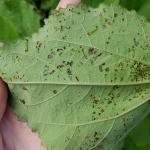

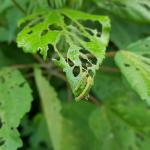
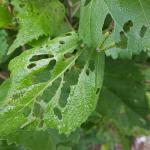 Hibiscus Sawfly: The larvae of the Hibiscus (mallow) sawfly, likely Atomacera decepta, were observed feeding on Hibiscus hosts in Amherst, MA on 7/24/19. Sawfly larvae develop into wasp-like adults (Order: Hymenoptera) and therefore these “caterpillars” will not be managed by Bacillus thuringiensis var. kurstaki which is specific to the Lepidoptera (caterpillars that develop into moths or butterflies as adults). Reduced risk active ingredients such as spinosad are labelled for use against sawfly larvae. However, given that Hibiscus are very attractive to pollinators, non-chemical management options such as hand picking and disposing of larvae, when possible, are best. Spinosad is toxic to pollinators until it dries. For more information about the risks of insecticide active ingredients to pollinators, visit: https://ag.umass.edu/landscape/fact-sheets/tree-shrub-insecticide-active-ingredients-risks-to-pollinators-other-non
Hibiscus Sawfly: The larvae of the Hibiscus (mallow) sawfly, likely Atomacera decepta, were observed feeding on Hibiscus hosts in Amherst, MA on 7/24/19. Sawfly larvae develop into wasp-like adults (Order: Hymenoptera) and therefore these “caterpillars” will not be managed by Bacillus thuringiensis var. kurstaki which is specific to the Lepidoptera (caterpillars that develop into moths or butterflies as adults). Reduced risk active ingredients such as spinosad are labelled for use against sawfly larvae. However, given that Hibiscus are very attractive to pollinators, non-chemical management options such as hand picking and disposing of larvae, when possible, are best. Spinosad is toxic to pollinators until it dries. For more information about the risks of insecticide active ingredients to pollinators, visit: https://ag.umass.edu/landscape/fact-sheets/tree-shrub-insecticide-active-ingredients-risks-to-pollinators-other-non
The Hibiscus (mallow) sawfly adult female uses her ovipositor to cut slits into leaf surfaces to deposit her eggs. Larvae emerge from these eggs and begin by first feeding on leaf undersides when small, and then move to feed on leaf surfaces as they grow in size. Only large leaf veins may be left behind if the population is large enough. Larvae have been observed moving to the base of the plant to pupate. Adults emerge and in some locations in the US, multiple generations have been recorded per year. This insect is known in the mid-Atlantic and Midwest states, but was reported feeding on Hibiscus spp. in Connecticut in 2004 and 2005 and has previously been reported in Massachusetts. The timing of the life cycle of this insect, as well as how many generations occur per year in Massachusetts, however, is not fully understood. Some research has shown that Hibiscus acetosella, H. aculeatus, and H. grandiflora seem to either exhibit some resistance to or tolerance of Hibiscus sawfly feeding. In one study, all three had few if any eggs or larvae and were given the lowest damage rating among the species evaluated. This insect also does not feed on rose of Sharon or H. rosasinensis. It has, however, been reported to “voraciously” feed on H. moscheutos, H. palustris, H. militaris, and H. lasiocarpus.
- Imported Willow Leaf Beetle: Plagiodera versicolora adult beetles overwinter near susceptible hosts. A few adult imported willow leaf beetles were seen feeding on willow foliage in Chesterfield, MA on 5/11/19 and no mating or egg laying was seen at the time.By 5/22/19, it was very easy to spot adult imported willow leaf beetles feeding and mating, as well as the damage they cause to the leaves. Egg laying was also observed on 5/22/19. On 5/29/19, feeding adult beetles and clusters of eggs were still observed. No larvae were yet seen at this particular location at that time. However, by 6/2/19, clusters of eggs hatched and tiny, feeding imported willow leaf beetle larvae could be seen. These yellowish larvae skeletonize the leaf in groups. Larvae were observed feeding on Japanese pussy willow and corkscrew willow on 6/12/19 in Boylston, MA. Extensive skeletonization of leaves was occurring on the corkscrew willow, in particular, at this location. Larvae are slug-like and bluish-green to yellow in color. They will feed in clusters and skeletonize the leaves. By 7/10/19 in Chesterfield, MA, larvae have pupated and adult imported willow leaf beetles are again present and feeding on willow foliage. Most plants can tolerate the feeding from this insect, and foliage will appear brown. Repeated yearly feeding can be an issue, in which case management of the young larvae may be necessary. Take care with treatment in areas near water.
- Japanese Beetle: Popillia japonica adult beetles are active. Adult female beetles will lay their eggs primarily by early August, however eggs may be laid into September. Females lay these eggs in groups in soil cavities they excavate 2-4 inches down. Japanese beetles overwinter as nearly grown grubs in the soil which are capable of evading freezing behaviorally by moving below the frost line. As soils warm in the spring, larvae become active and feed on the roots of grasses. Pupation occurs 1-3 feet below the soil surface. Adults emerge from these lawn areas and disperse to feed on foliage, mate, and return to turf-type locations for females to lay their eggs. Japanese beetle adults use aggregation pheromones (chemicals that signal between individuals) to call in others of the same species. These pheromones and volatile chemicals from host plants being fed upon are thought to be the reason why large numbers of these beetles can be found feeding together. Adult beetles feed on foliage and flowers, often skeletonizing leaves until they appear lace-like. Larvae are highly damaging turf pests. Tree and shrub hosts are comprised of more than 300 species including but not limited to rose, mountain-ash, willow, linden, elm, Japanese and Norway maples, birch, sycamore, rose of Sharon, ornamental apple, and many others. Adult beetles are often attracted to feeding on sunny areas of the plant. Many organisms are parasitoids of Japanese beetles, such as two wasps that attack overwintered grubs in the spring, and a tachinid fly (winsome fly: Istocheta aldrichi) which parasitizes newly emerged adult beetles. Other organisms act as generalist predators with Japanese beetles on their menus, including but not limited to ants, certain other beetles, small mammals, and birds. See regional reports above regarding Japanese beetle activity.

 Lace Bugs: heavy lace bug feeding was observed on 7/24/19 in Amherst, MA on Aronia spp. The culprit is suspected to be Corythucha cydoniae, commonly referred to as the hawthorn lace bug, as this species has previously been recorded on Aronia spp. in Massachusetts in the literature. C. cydoniae has a wide host range beyond hawthorn, however it can be difficult to distinguish from other closely related species in the field so this identification should be considered tentative. The impacted plant exhibited the tell-tale signs of lace bug feeding: leaf surfaces were stippled/bleached/silvery/chlorotic in appearance due to nymphal and adult lace bug feeding with piercing-sucking mouthparts below. Flipping the leaves over revealed the feeding insects, as well as the sticky, black, tar-like spots of their excrement. This particular plant, as may be common for Aronia spp., was located immediately adjacent to a pond. Therefore, exercise caution when making management decisions near bodies of water.
Lace Bugs: heavy lace bug feeding was observed on 7/24/19 in Amherst, MA on Aronia spp. The culprit is suspected to be Corythucha cydoniae, commonly referred to as the hawthorn lace bug, as this species has previously been recorded on Aronia spp. in Massachusetts in the literature. C. cydoniae has a wide host range beyond hawthorn, however it can be difficult to distinguish from other closely related species in the field so this identification should be considered tentative. The impacted plant exhibited the tell-tale signs of lace bug feeding: leaf surfaces were stippled/bleached/silvery/chlorotic in appearance due to nymphal and adult lace bug feeding with piercing-sucking mouthparts below. Flipping the leaves over revealed the feeding insects, as well as the sticky, black, tar-like spots of their excrement. This particular plant, as may be common for Aronia spp., was located immediately adjacent to a pond. Therefore, exercise caution when making management decisions near bodies of water.- Spotted Lanternfly: (Lycorma delicatula, SLF) is not known to occur in Massachusetts landscapes (no established populations are known in MA at this time). However, officials with the Massachusetts Department of Agricultural Resources (MDAR) urged residents to check plants for spotted lanternfly. On February 21, 2019 MDAR announced the discovery of a single dead spotted lanternfly adult at a private residence in Boston. As a result of this discovery, officials asked the public to check potted plants they purchase and report any suspicious insects. MDAR reports that this particular individual appeared to have been unintentionally transported this past December in a shipment of poinsettia plants originating from Pennsylvania. Officials also report that there is currently no evidence that this pest has become established in MA. For more information about this finding, please visit the MA Department of Agricultural Resources press release: https://www.mass.gov/news/state-agricultural-officials-urge-residents-to-check-plants-for-spotted-lanternfly .
This insect is a member of the Order Hemiptera (true bugs, cicadas, hoppers, aphids, and others) and the Family Fulgoridae, also known as planthoppers. The spotted lanternfly is a non-native species first detected in the United States in Berks County, Pennsylvania and confirmed on September 22, 2014.
The spotted lanternfly is considered native to China, India, and Vietnam. It has been introduced as a non-native insect to South Korea and Japan, prior to its detection in the United States. In South Korea, it is considered invasive and a pest of grapes and peaches. The spotted lanternfly has been reported from over 70 species of plants, including the following: tree of heaven (Ailanthus altissima) (preferred host), apple (Malus spp.), plum, cherry, peach, apricot (Prunus spp.), grape (Vitis spp.), pine (Pinus spp.), pignut hickory (Carya glabra), Sassafras (Sassafras albidum), serviceberry (Amelanchier spp.), slippery elm (Ulmus rubra), tulip poplar (Liriodendron tulipifera), white ash (Fraxinus americana), willow (Salix spp.), American beech (Fagus grandifolia), American linden (Tilia americana), American sycamore (Platanus occidentalis), big-toothed aspen (Populus grandidentata), black birch (Betula lenta), black cherry (Prunus serotina), black gum (Nyssa sylvatica), black walnut (Juglans nigra), dogwood (Cornus spp.), Japanese snowbell (Styrax japonicus), maple (Acer spp.), oak (Quercus spp.), and paper birch (Betula papyrifera).
The adults and immatures of this species damage host plants by feeding on sap from stems, leaves, and the trunks of trees. In the springtime in Pennsylvania (late April - mid-May) nymphs (immatures) are found on smaller plants and vines and new growth of trees and shrubs. Third and fourth instar nymphs migrate to the tree of heaven and are observed feeding on trunks and branches. Trees may be found with sap weeping from the wounds caused by the insect’s feeding. The sugary secretions (excrement) created by this insect may coat the host plant, later leading to the growth of sooty mold. Insects such as wasps, hornets, bees, and ants may also be attracted to the sugary waste created by the lanternflies, or sap weeping from open wounds in the host plant. Host plants have been described as giving off a fermented odor when this insect is present.
Adults are present by the middle of July in Pennsylvania and begin laying eggs by late September and continue laying eggs through late November and even early December in that state. Adults may be found on the trunks of trees such as the tree of heaven or other host plants growing in close proximity to them. Egg masses of this insect are gray in color and, in some ways, look similar to gypsy moth egg masses.
Host plants, bricks, stone, lawn furniture, recreational vehicles, and other smooth surfaces can be inspected for egg masses. Egg masses laid on outdoor residential items such as those listed above may pose the greatest threat for spreading this insect via human aided movement.
For more information about the spotted lanternfly, visit this fact sheet: https://ag.umass.edu/landscape/fact-sheets/spotted-lanternfly .
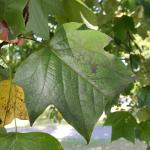
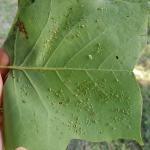
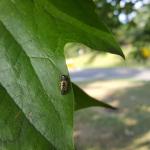 Tuliptree Aphid: Illinoia liriodendri is a species of aphid associated with the tuliptree, wherever it is grown. The tuliptree aphid was seen feeding on the undersides of leaves on 7/25/19 in Amherst, MA. Depending upon local temperatures, these aphids may be present from mid-June through early fall. Large populations can develop by late summer. Some leaves, especially those in the outer canopy, may turn brown or yellow and drop from infested trees prematurely. The most significant impact these aphids can have is typically the resulting honeydew, or sugary excrement, which may be present in excessive amounts and coat leaves and branches, leading to sooty mold growth. This honeydew may also make a mess of anything beneath the tree. Wingless adults are approximately 1/8 inch in length, oval, and can range in color from pale green to yellow. There are several generations per year. This is a native insect. Management is typically not necessary, as this insect does not significantly impact the overall health of its host. Tuliptree aphids also have plenty of natural enemies, such as ladybeetles and parasites.
Tuliptree Aphid: Illinoia liriodendri is a species of aphid associated with the tuliptree, wherever it is grown. The tuliptree aphid was seen feeding on the undersides of leaves on 7/25/19 in Amherst, MA. Depending upon local temperatures, these aphids may be present from mid-June through early fall. Large populations can develop by late summer. Some leaves, especially those in the outer canopy, may turn brown or yellow and drop from infested trees prematurely. The most significant impact these aphids can have is typically the resulting honeydew, or sugary excrement, which may be present in excessive amounts and coat leaves and branches, leading to sooty mold growth. This honeydew may also make a mess of anything beneath the tree. Wingless adults are approximately 1/8 inch in length, oval, and can range in color from pale green to yellow. There are several generations per year. This is a native insect. Management is typically not necessary, as this insect does not significantly impact the overall health of its host. Tuliptree aphids also have plenty of natural enemies, such as ladybeetles and parasites. Viburnum Leaf Beetle: Pyrrhalta viburni is a beetle in the family Chrysomelidae that is native to Europe, but was found in Massachusetts in 2004. In Amherst, MA on 7/9/19 and again on 7/24/19, adult Viburnum leaf beetles were found mating, feeding, and laying eggs at this location following pupation. Females will lay their eggs in pits they chew at the ends of twigs. Eggs overwinter. Adults may also migrate to previously not yet infested plants. This beetle feeds exclusively on many different species of Viburnum, which includes, but is not limited to, susceptible plants such as V. dentatum, V. nudum, V. opulus, V. propinquum, and V. rafinesquianum. Larvae may be treated with a product containing spinosad. Some Viburnum have been observed to have varying levels of resistance to this insect, including but not limited to V. bodnantense, V. carlesii, V. davidii, V. plicatum, V. rhytidophyllum, V. setigerum, and V. sieboldii. More information about Viburnum leaf beetle may be found at http://www.hort.cornell.edu/vlb/ .
Viburnum Leaf Beetle: Pyrrhalta viburni is a beetle in the family Chrysomelidae that is native to Europe, but was found in Massachusetts in 2004. In Amherst, MA on 7/9/19 and again on 7/24/19, adult Viburnum leaf beetles were found mating, feeding, and laying eggs at this location following pupation. Females will lay their eggs in pits they chew at the ends of twigs. Eggs overwinter. Adults may also migrate to previously not yet infested plants. This beetle feeds exclusively on many different species of Viburnum, which includes, but is not limited to, susceptible plants such as V. dentatum, V. nudum, V. opulus, V. propinquum, and V. rafinesquianum. Larvae may be treated with a product containing spinosad. Some Viburnum have been observed to have varying levels of resistance to this insect, including but not limited to V. bodnantense, V. carlesii, V. davidii, V. plicatum, V. rhytidophyllum, V. setigerum, and V. sieboldii. More information about Viburnum leaf beetle may be found at http://www.hort.cornell.edu/vlb/ .
Concerned that you may have found an invasive insect or suspicious damage caused by one? Need to report a pest sighting? If so, please visit the Massachusetts Introduced Pests Outreach Project: http://massnrc.org/pests/pestreports.htm .
A note about Tick Awareness: deer ticks (Ixodes scapularis), the American dog tick (Dermacentor variabilis), and the lone star tick (Amblyomma americanum) are all found throughout Massachusetts. Each can carry their own complement of diseases. Anyone working in tick habitats (wood-line areas, forested areas, and landscaped areas with ground cover) should check themselves regularly for ticks while practicing preventative measures. Have a tick and need it tested? Visit the web page of the UMass Laboratory of Medical Zoology (https://www.tickreport.com/ ) and click on the blue Order a TickReport button for more information.
Reported by Tawny Simisky, Extension Entomologist, UMass Extension Landscape, Nursery, & Urban Forestry Program
Additional Resources
To receive immediate notification when the next Landscape Message update is posted, be sure to join our e-mail list and follow us on Facebook and Twitter.
For a complete listing of upcoming events, see our Upcoming Educational Events page.
For commercial growers of greenhouse crops and flowers - Check out UMass Extension's Greenhouse Update website
For professional turf managers - Check out Turf Management Updates
For home gardeners and garden retailers - Check out home lawn and garden resources. UMass Extension also has a Twitter feed that provides timely, daily gardening tips, sunrise and sunset times to home gardeners, see https://twitter.com/UMassGardenClip
Diagnostic Services
A UMass Laboratory Diagnoses Landscape and Turf Problems - The UMass Extension Plant Diagnostic Lab is available to serve commercial landscape contractors, turf managers, arborists, nurseries and other green industry professionals. It provides woody plant and turf disease analysis, woody plant and turf insect identification, turfgrass identification, weed identification, and offers a report of pest management strategies that are research based, economically sound and environmentally appropriate for the situation. Accurate diagnosis for a turf or landscape problem can often eliminate or reduce the need for pesticide use. For sampling procedures, detailed submission instructions and a list of fees, see Plant Diagnostics Laboratory
Soil and Plant Nutrient Testing - The University of Massachusetts Soil and Plant Nutrient Testing Laboratory is located on the campus of The University of Massachusetts at Amherst. Testing services are available to all. The function of the Soil and Plant Nutrient Testing Laboratory is to provide test results and recommendations that lead to the wise and economical use of soils and soil amendments. For complete information, visit the UMass Soil and Plant Nutrient Testing Laboratory web site. Alternatively, call the lab at (413) 545-2311.
Ticks are active at this time! Remember to take appropriate precautions when working and playing outdoors, and conduct daily tick checks. UMass tests ticks for the presence of Lyme disease and other disease pathogens. Learn more.

